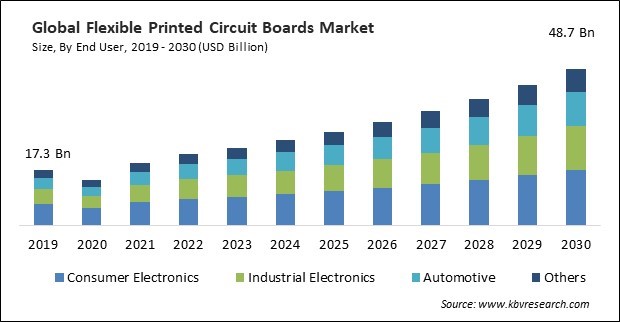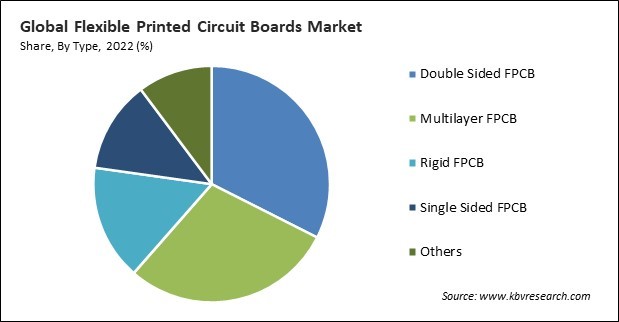The Global Flexible Printed Circuit Boards Market size is expected to reach $48.7 billion by 2030, rising at a market growth of 10.5% CAGR during the forecast period. In the year 2022, the market attained a volume of 69,13,230.9 million Units experiencing a growth of 10.4% (2019-2022).
Consumer electronic devices, especially smartphones, are becoming increasingly compact and lightweight. Therefore, Consumer Electronics segment generated $8,205.4 million revenue in the market in 2022. Unlike traditional rigid printed circuit boards (PCBs), FPCBs can be bent and folded. This flexibility is essential for devices like wearables and foldable smartphones, where conventional rigid boards would be impractical. FPCBs enable the creation of sleek and innovative designs that align with consumer preferences for portable and aesthetically pleasing electronic devices. Some of the factors impacting the market are miniaturization of various types of electronics, emergence of the Internet of things and complex manufacturing processes of FPCBs.

FPCBs are incredibly thin and lightweight compared to traditional rigid printed circuit boards (PCBs). This makes them ideal for applications where space constraints are critical. In modern electronic devices like smartphones and wearables, every millimetre of space matters. FPCBs are inherently flexible, which means they can be bent, folded, or twisted to fit the contours of a device's casing. This flexibility allows for the creation of three-dimensional designs, accommodating the irregular shapes and structures found in many electronic products. Additionally, the deployment of IoT sensors and edge devices in various industries relies on FPCBs to accommodate the required electronics in constrained spaces. FPCBs can be customized to fit irregular shapes and spaces, making them essential for manufacturing sensors used in IoT applications. IoT devices often incorporate many sensors and components that require high-density interconnections. FPCBs can provide the necessary density and connectivity to integrate numerous components in a small space. Therefore, these aspects will drive the expansion of the market and these aspects will pose lucrative growth prospects for the market in the future.
However, Industries that require rapid product development, such as consumer electronics or emerging technologies, often face stringent time-to-market constraints. Longer lead times in FPCB production could delay the overall product development process. Delays can impact the release of new devices, leading to missed market opportunities and potentially impacting the competitive edge of a company. The longer production cycles and higher manufacturing costs associated with complex FPCB production can significantly impact the overall cost of the final products. As a result, these aspects could hinder the expansion of the market in the coming years.
Based on type, the market is segmented into multilayer FPCB, double sided FPCB, single sided FPCB, rigid FPCB, and others. In 2022, the double sided FPCB segment garnered the largest revenue share in the market. The need for compact and lightweight electronic devices has led to the growth of double-sided FPCBs. These boards offer increased circuit density in a limited space, supporting miniaturization without compromising functionality. Double-sided FPCBs enable more intricate designs, accommodating more components and connections. This flexibility in design allows for complex and compact electronic assemblies in various applications. Therefore, these aspects will help in the expansion of the segment.

On the basis of end user, the market is divided into consumer electronics, automotive, industrial electronics, and others. In 2022, the industrial electronics segment witnessed a substantial revenue share in the market. The growth of industrial automation across various sectors, including manufacturing, automotive, and robotics, has led to increased demand for FPCBs. These boards are integral to automation systems due to their flexibility, space-saving design, and durability. The expansion of the Industrial Internet of Things (IIoT) relies heavily on FPCBs to enable connectivity, data collection, and sensor integration. FPCBs play a crucial role in developing IoT devices used in industrial environments for monitoring, control, and predictive maintenance. These factors will pose lucrative growth prospects for the segment.
| Report Attribute | Details |
|---|---|
| Market size value in 2022 | USD 22.1 Billion |
| Market size forecast in 2030 | USD 48.7 Billion |
| Base Year | 2022 |
| Historical Period | 2019 to 2021 |
| Forecast Period | 2023 to 2030 |
| Revenue Growth Rate | CAGR of 10.5% from 2023 to 2030 |
| Number of Pages | 328 |
| Number of Table | 570 |
| Quantitative Data | Volume in Million Units, Revenue in USD Billion, and CAGR from 2019 to 2030 |
| Report coverage | Market Trends, Revenue Estimation and Forecast, Segmentation Analysis, Regional and Country Breakdown, Porter’s 5 Forces Analysis, Company Profiling, Companies Strategic Developments, SWOT Analysis, Winning Imperatives |
| Segments covered | Type, End User, Region |
| Country scope |
|
| Companies Included | Sumitomo Electric Industries, Ltd., Nitto Denko Corporation, Suzhou Dongshan Precision Manufacturing Co., Ltd., Fujikura Ltd., Benchmark Electronics, Inc., NOK Corporation, Ichia Technologies Inc., Zhen Ding Technology Holding Limited, Flexium Interconnect, Inc. and Interflex co., ltd. |
| Growth Drivers |
|
| Restraints |
|
By region, the market is segmented into North America, Europe, Asia Pacific, and LAMEA. The Asia Pacific segment procured the highest revenue share in the market in 2022. Asia Pacific, particularly countries like China, Japan, South Korea, and Taiwan, has established itself as a global manufacturing hub for electronics. These countries boast advanced manufacturing capabilities and facilities, making them key players in FPCB production. The APAC region offers cost-effective manufacturing solutions. The relatively lower labor costs, combined with well-developed infrastructure and supply chain networks, make it an attractive region for FPCB production. These aspects will boost the demand in the segment.
Free Valuable Insights: Global Flexible Printed Circuit Boards Market size to reach USD 48.7 Billion by 2030
The market research report covers the analysis of key stake holders of the market. Key companies profiled in the report include Sumitomo Electric Industries, Ltd., Nitto Denko Corporation, Suzhou Dongshan Precision Manufacturing Co., Ltd., Fujikura Ltd., Benchmark Electronics, Inc., NOK Corporation, Ichia Technologies Inc., Zhen Ding Technology Holding Limited, Flexium Interconnect, Inc. and Interflex co., ltd.
By End User (Volume, Million Units, USD Billion/Million, 2019-2030)
By Type (Volume, Million Units, USD Billion/Million, 2019-2030)
By Geography (Volume, Million Units, USD Billion/Million, 2019-2030)
This Market size is expected to reach $48.7 billion by 2030.
Miniaturization of various types of electronics are driving the Market in coming years, however, Complex manufacturing processes of FPCBs restraints the growth of the Market.
Sumitomo Electric Industries, Ltd., Nitto Denko Corporation, Suzhou Dongshan Precision Manufacturing Co., Ltd., Fujikura Ltd., Benchmark Electronics, Inc., NOK Corporation, Ichia Technologies Inc., Zhen Ding Technology Holding Limited, Flexium Interconnect, Inc. and Interflex co., ltd.
In the year 2022, the market attained a volume of 69,13,230.9 million Units experiencing a growth of 10.4% (2019-2022).
The Consumer Electronics segment is generating the highest revenue in the Market, by End User in 2022; thereby, achieving a market value of $17.1 Billion by 2030.
The Asia Pacific region dominated the Market, by region in 2022, and would continue to be a dominant market till 2030; thereby, achieving a market value of $19.5 Billion by 2030.
Our team of dedicated experts can provide you with attractive expansion opportunities for your business.

